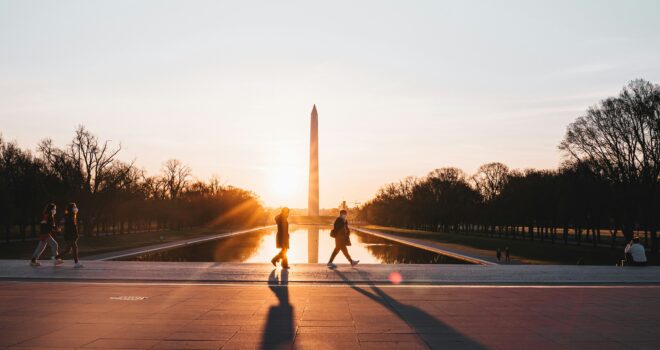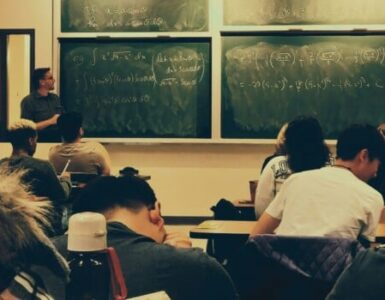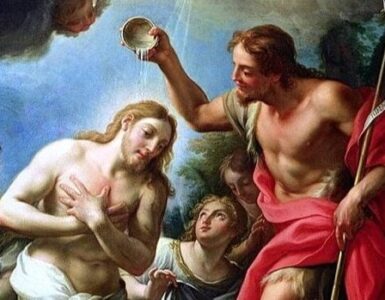Editor’s Note: This is the second half of a two-part series on making a pilgrimage to Washington, DC.
In a previous article, we considered the ways that a visitor to Washington, DC, can be reminded easily that American Christians are citizens of more than one nation, that we are citizens also of a heavenly Kingdom. Our dual citizenship requires that we view our rights and responsibilities in the republic in light of our citizenship under Heaven. Our nation’s capital contains a treasury of amazing sites that have great potential to assist us in learning those lessons successfully.
The locus of these sights is north of the downtown area, anchored by the Catholic University of America. At the edge of the university’s campus stands the Basilica of the National Shrine of the Immaculate Conception, frequently called “America’s Catholic Church.” Constructed and developed in a unique and intriguing combination of Byzantine and Romanesque architecture, it is the largest Roman Catholic church structure in North America, and it cracks the top ten largest worldwide. Many of its more than 80 chapels and oratories are devoted to unique cultural expressions of devotion to Our Blessed Mother. While these chapels acknowledge wide diversity within the Catholic faith, the whole structure exudes the reality that citizens of, and migrants from, all nations can find citizenship in the Catholic faith and the Kingdom of Heaven.1
The basilica is also a repository for countless unique and inspiring pieces of art. The church’s seven domes are covered with stunning Byzantine-style mosaics, recalling various parts of the story of God’s covenants from creation. Of course, the most memorable of all these is the mosaic covering the apse behind the main altar, Christ in Majesty. It seems impossible that a pilgrim could walk away without reflecting at least briefly on the way to live in this world before meeting Jesus at his or her particular judgment.
Another memorable piece of art is a stone carving that contributes the basilica’s Romanesque style. The Universal Call to Holiness gives visual expression to one of the central teachings of the Second Vatican Council. The carving depicts the Holy Spirit sending out His power and grace upon people of all ages, ethnicities, and social statuses, signifying that every baptized person is both called and equipped to help the Kingdom of Heaven make inroad in earthly kingdoms. It is strategically placed at the rear of the church, so that worshipers have a reminder of their vocational mission when they transition from this sacred space into the secular world.
Not far outside the Basilica’s doors stands another memorable sculpture. Angels Unawares, a replica of the sculpture installed at St. Peter’s Square in Rome in 2019, draws its title from Hebrews 13:2. According to the artist, Timothy Schmalz, this piece of art expresses the Catholic belief that “there is to be found the sacred in the stranger, in terms of the refugee and migrant people.”2 Aside from questions of immigration policy by any nation-state, this biblical passage and sculpture remind every visitor that we are all pilgrims, migrants toward our heavenly homeland, and that we are called to treat each other as such.
Just a short distance on the other side of the Basilica is the Saint John Paul II National Shrine. The shrine is a pastoral initiative of the Knights of Columbus to continue spreading the message of hope that the great saint shared with the world during his papacy. The shrine contains a museum that tells the story of this man’s life as he encountered and engaged with the worst evils and tragedies of the twentieth century. The center of the shrine is the Redeemer of Man Church, which offers a mosaic-art reflection on the theme at the center of John Paul’s papacy. Finally, there is the Luminous Mysteries Chapel, remembering this special set of mysteries that the holy father added to the Rosary, and which contains a first-class relic of one of the twentieth centuries greatest Christian witnesses. Currently, there is also a relic of Bl. Carlo Acutis, who will be canonized in 2025.
All of these elements allow pilgrims to ponder the great pope’s continual reminder throughout his pontificate: No thing or person will fulfill the deepest longings of our hearts or solve the world’s problems except for Jesus Christ, the Lord of History and the Redeemer of Man. Through daily availability of Confession, Mass, and the Divine Mercy Chaplet, pilgrims can access the graces of God so they are strengthened as witnesses to hope and God’s mercy in a dark world.
Another site in this area that should be on every pilgrim’s “must visit” list is the Franciscan Monastery of the Holy Land. This monastery was built as an homage to the Franciscan friars who began custodial service and archeological studies in the Holy Land more than 700 years ago, in the thirteenth century. On the lower level, there are grotto chapels commemorating the Annunciation to Mary and the Nativity of Our Lord. The main level contains a number of side chapels surrounding a beautiful High Altar.
Among these, many pilgrims might find the two elevated chapels to be significant highlights. To commemorate Jesus’ ascent of Mount Tabor, there is an artistic rendering of the Transfiguration in one chapel. Directly across the church is the Calvary Altar, which sits within a chapel dedicated to Jesus’ Crucifixion. A pilgrim must ascend steep steps in imitation of Jesus’ ascent to Golgotha. A pilgrim gazes up at a cross that is exactly the height of the cross that bore the body of Our Crucified Lord on that Good Friday. Beneath is a small opening, which the pilgrim can reach out and touch, to replicate the exact spot where the Crucifix stood. Life-sized statues of Jesus and other figures fill the space, inviting the pilgrim to place himself or herself intimately in the scene.
Then, after descending the steps from the Calvary Altar, a pilgrim can cross the church again to visit replicas-to-scale of an anointing stone outside the Holy Sepulchre (see Jn. 19:40). The whole set up offers a somber, profound experience as the pilgrim realizes that these replicas of Calvary and Jesus’ tomb stand at the identical distance of the actual spots in Jerusalem. It is deeply moving to add spatial details to the events that opened the Kingdom of Heaven to the citizens of this world.
The presence of these inspiring sites helps us understand that a visit to Washington, DC, provides far more than history and civics lessons. A person who visits our nation’s capital as a Catholic pilgrim can be immersed into a deeper experience of the salvific mystery of Jesus Christ. And that, we know, is the ultimate source of inspiration for living as a good citizen of two related kingdoms.
1See “The History and Heritage of America’s Catholic Church,” on Basilica of the National Shrine of the Immaculate Conception.
2“Angels Unawares,” on Sculpture by Timothy P. Schmalz.
Photo by Eric Dekker on Unsplash
Christ in Majesty. [mosaic]. Retrieved from NationalShrine.org.
Franciscan Monastery of the Holy Land. Washington, DC. Retrieved from Franciscan Monastery of the Holy Land in America.











